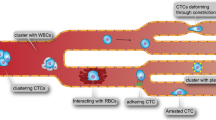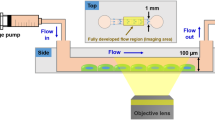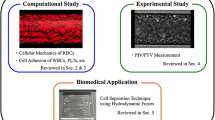Abstract
In this review, we summarize the current state of understanding of the processes by which leukocytes, and other cells, such as tumor cells interact with the endothelium under various blood flow conditions. It is shown that the interactions are influenced by cell–cell adhesion properties, shear stresses due to the flow field and can also be modified by the cells microrheological properties. Different adhesion proteins are known to be involved leading to particular mechanisms by which interactions take place during inflammation or metastasis. Cell rolling, spreading, migration are discussed, as well as the effect of flow conditions on these mechanisms, including microfluidic effects. Several mathematical models proposed in recent years capturing the essential features of such interaction mechanisms are reviewed. Finally, we present a recent model in which the adhesion is given by a kinetics theory based model and the cell itself is modeled as a viscoelastic drop. Qualitative agreement is found between the predictions of this model and in vitro experiments.
Similar content being viewed by others
References
A-Hassan E., Heinz W.F., Antonik M.D., D’Costa N.P., Nageswaran S., Schoenenberger C.A. and Hoh J.H. (1998). Relative microelastic mapping of living cells by atomic force microscopy. Biophys. J. 74(3): 1564–1578
Alberts B., Bray D., Lewis J., Raff M., Roberts K. and Watson. J.D. (1994). Molecular biology of the cell, 3rd edn. Garland Science, Oxford
Alon R., Chen S., Puri K.D., Finger E.B. and Springer T.A. (1997). The kinetics of l-selectin tethers and the mechanics of selectin-mediated rolling. J. Cell Biol. 138: 1169–1180
Alon R., Hammer D.A. and Springer T.A. (1995). Lifetime of the p-selectin-carbohydrate bond and its response to tensile force in hydrodynamic flow. Nature 374(6522): 539–542
Atherton A. and Born G.V. (1973). Relationship between the velocity of rolling granulocytes and that of the blood flow in venules. J. Physiol. 233(1): 157–165
Barthès-Biesel D. and Rallison J.M. (1981). The time-dependent deformation of a capsule freely suspended in a linear shear flow. J. Fluid mech. 113: 251–267
Bausch A.R. and Kroy K. (2006). A bottom-up approach to cell mechanics. Nat. Phys. 2: 231–238
Bell G.I. (1978). Models for the specific adhesion of cells to cells. Science 200(4342): 618–627
Bell G.I., Dembo M. and Bongrand P. (1984). Cell adhesion. competition between nonspecific repulsion and specific bonding. Biophys. J. 45(6): 1051–1064
Benoit M., Gabriel D., Gerisch G. and Gaub H.E. (2000). Discrete interactions in cell adhesion measured by single-molecule force spectroscopy. Nat. Cell Biol. 2(6): 313–317
Bershadsky A.D., Tint I.S., Neyfakh A.A. and Vasiliev J.M. (1985). Focal contacts of normal and rsv-transformed quail cells. hypothesis of the transformation-induced deficient maturation of focal contacts. Exp. Cell Res. 158(2): 433–444
Biben T. and Misbah C. (2003). Tumbling of vesicles under shear flow within an advected-field approach. Phys. Rev. E 67(3): 031, 908
Binnig G., Quate C.F. and Gerber C. (1986). Atomic force microscope. Phys. Rev. Lett. 56(9): 930–933
Bohnet S., Ananthakrishnan R., Mogilner A., Meister J.J. and Verkhovsky A.B. (2006). Weak force stalls protrusion at the leading edge of the lamellipodium. Biophys. J. 90: 1810–1820
Brenner H. (1961). The slow viscous motion of a sphere through a fluid toward a plane surface. Chem. Eng. Sci. 16: 242–251
Canetta E., Duperray A., Leyrat A. and Verdier C. (2005). Measuring cell viscoelastic properties using a force-spectrometer: influence of protein-cytoplasm interactions. Biorheology 42(5): 321–333
Canetta E., Leyrat A. and Verdier C. (2003). A physical model for studying adhesion between a living cell and a spherical functionalized substrate. Math. Comp. Model. 37: 1121–1129
Cantat I. and Misbah C. (1999). Lift force and dynamical unbinding of adhering vesicles under shear flow. Phys. Rev. Lett. 83(4): 880–883
Cao J., Donell B., Deaver D.R., Lawrence M.B. and Dong C. (1998). In vitro side-view imaging technique and analysis of human t-leukemic cell adhesion to icam-1 in shear flow. Microvasc. Res. 55: 124–137
Caputo K.E., Lee D., King M.R. and Hammer D.A. (2007). Adhesive dynamics simulations of the shear threshold effect for leukocytes. Biophys. J. 92: 787–797
Chang K.C. and Hammer D.A. (2000). Adhesive dynamics simulations of sialyl-lewis(x)/e-selectin-mediated rolling in a cell-free system. Biophys. J. 79(4): 1891–1902
Chang K.C., Tees D.F.J. and Hammer D.A. (2000). The state diagram for cell adhesion under flow: Leukocyte rolling and firm adhesion. Proc. Natl. Acad. Sci. USA 97(21): 11,262–11,267
Chen S. and Springer T.A. (1999). An automatic braking system that stabilizes leukocyte rolling by an increase in selectin bond number with shear. J. Cell Biol. 144(1): 185–200
Choquet D., Felsenfeld D.P. and Sheetz M.P. (1997). Extracellular matrix rigidity causes strengthening of integrin-cytoskeleton linkages. Cell 88(1): 39–48
Chotard-Ghodsnia R., Drochon A., Duperray A., Leyrat A. and Verdier C. (2003). Static and dynamic interactions between circulating cells and the endothelium in cancer. In: Preziosi, L. (eds) Cancer Modelling and Simulation, Chap. 9, pp 243–267. CRC Press, Boca Raton, FL
Chotard-Ghodsnia R., Drochon A. and Grebe R. (2002). A new flow chamber for the study of shear stress and transmural pressure upon cells adhering to a porous biomaterial. J. Biomech. Eng. 124: 258–261
Chotard-Ghodsnia R., Haddad O., Leyrat A., Drochon A., Verdier C. and Duperray A. (2007). Morphological analysis of tumor cell/endothelial cell interactions under shear flow. J. Biomech. 40(2): 335–344
Coughlin M.F. and Schmid-Schönbein G.W. (2004). Pseudopod projection and cell spreading of passive leukocytes in response to fluid shear stress. Biophys. J. 87: 2035–2042
Crocker J.C., Valentine M.T., Weeks E.R., Gisler T., Kaplan P.D., Yodh A.G. and Weitz D.A. (2000). Two-point microrheology of inhomogeneous soft materials. Phys. Rev. Lett. 85(4): 888–891
Décavé E., Garrivier D., Bréchet Y., Fourcade B. and Brückert F. (2002). Shear flow-induced detachment kinetics of dictyostelium discoideum cells from solid substrate. Biophys. J. 82(5): 2383–2395
Dembo M., Torney D.C., Saxman K. and Hammer D. (1988). The reaction-limited kinetics of membrane-to-surface adhesion and detachment. Proc. R. Soc. Lond. B 234: 55–83
Dong C., Cao J., Struble E.J. and Lipowski H.H. (1999). Mechanics of leukocyte deformation and adhesion to endothelium in shear flow. Ann. Biomed. Eng. 27: 298–312
Drury J.L. and Dembo M. (1999). Hydrodynamics of micropipette aspiration. Biophys. J. 76(1): 110–128
Endlich N. and Endlich K. (2006). Stretch, tension and adhesion—adaptive mechanisms of the actin cytoskeleton in podocytes. Eur. J. Cell Biol. 85(3–4): 229–234
Euteneuer U. and Schliwa M. (1984). Persistent, directional motility of cells and cytoplasmic fragments in the absence of microtubules. Nature 310(5972): 58–61
Evans E., Leung A., Heinrich V. and Zhu C. (2004). Mechanical switching and coupling between two dissociation pathways in a p-selectin adhesion bond. Proc. Natl. Acad. Sci. USA 101(31): 11,281–11,286
Evans E. and Ritchie K. (1997). Dynamic strength of molecular adhesion bonds. Biophys. J. 72(4): 1541–1555
Evans E.A. (1985). Detailed mechanics of membrane-membrane adhesion and separation. i. continuum of molecular cross-bridges. Biophys. J. 48(1): 175–183
Evans E.A. (2001). Probing the relation between force-lifetime-and chemistry in single molecular bonds. Ann. Rev. Biophys. Biomol. Struct. 30: 105–128
Foty R.A. and Steinberg M.S. (2005). The differential adhesion hypothesis: a direct evaluation. Dev. Biol. 278(1): 255–263
Friedl P. and Bröcker E.B. (2000). The biology of cell locomotion within three-dimensional extracellular matrix. Cell Mol. Life Sci. 57(1): 41–64
Gardiner C.W. (1985). Handbook of Stochastic Methods for Physics, Chemistry and the Natural Sciences. Springer, Berlin
Glowinski R., Pan T.W., Hesla T.I. and Joseph D.D. (1998). A distributed lagrange multiplier/fictitious domain method for particulate flows. Int. J. Multiphase Flows 25: 201–233
Goldman A.J., Cox R.G. and Brenner H. (1967). Slow viscous motion of a sphere parallel to a plane wall. i. motion through a quiescent fluid. Chem. Eng. Sci. 22: 637–652
Goldman A.J., Cox R.G. and Brenner H. (1967). Slow viscous motion of a sphere parallel to a plane wall: Ii. couette flow. Chem. Eng. Sci. 22: 653–659
Hammer D.A. and Apte S.M. (1992). Simulation of cell rolling and adhesion on surfaces in shear flow: general results and analysis of selectin-mediated neutrophil adhesion. Biophys. J. 63(1): 35–57
Hammer D.A. and Lauffenburger D.A. (1987). A dynamical model for receptor-mediated cell adhesion to surfaces. Biophys. J. 52(3): 475–487
He X. and Dembo M. (1997). On the mechanics of the first cleavage division of the sea urchin egg. Exp. Cell Res. 233(2): 252–273
Hénon S., Lenormand G., Richert A. and Gallet F. (1999). A new determination of the shear modulus of the human erythrocyte membrane using optical tweezers. Biophys. J. 76(2): 1145–1151
Herant M., Heinrich V. and Dembo M. (2005). Mechanics of neutrophil phagocytosis: behavior of the cortical tension. J. Cell Sci. 118(9): 1789–1797
Hochmuth R.M. (2000). Micropipette aspiration of living cells. J. Biomech. 33(1): 15–22
Hussain M.A., Merchant S.N., Mombasawala L.S. and Puniyani R.R. (2004). A decrease in effective diameter of rat mesenteric venules due to leukocyte margination after a bolus injection of pentoxifylline-digital image analysis of an intravital microscopic observation. Microvasc. Res. 67(3): 237–244
Iguchi K., Oh G., Ookawa K., Yanagi K., Sakai M., Yamamoto T., Ishikawa S. and Onizuka M. (2007). In vivo observation of pulmonary micrometastasis of colon cancer in normal rats. Microvasc. Res. 73(3): 206–213
Israelachvili J.N. and Tabor D. (1972). The measurement of van der waals dispersion forces in the range 1.5 to 130 nm. Proc. Roy. Soc. Lond. A 331(1584): 19–38
Jadhav S., Eggleton C.D. and Konstantopoulos K. (2005). A 3-d computational model predicts that cell deformation affects selectin-mediated leukocyte rolling. Biophys. J. 88: 96–104
Jin Q., Verdier C., Singh P., Aubry N., Chotard-Ghodsnia R. and Duperray A. (2007). Migration and deformation of leukocytes in pressure driven flows. Mech. Res. Commun. 34: 411–422
Johnson-Léger C., Aurrand-Lions M. and Imhof B.A. (2000). The parting of the endothelium: miracle, or simply a junctional affair?J. Cell Sci. 113(6): 921–933
Jones D.A., Abbassi O., McIntire L.V., McEver R.P. and Smith C.W. (1993). P-selectin mediates neutrophil rolling on histamine-stimulated endothelial cells. Biophys. J. 65(4): 1560–1569
Kadaksham J., Singh P. and Aubry N. (2004). Dynamics of pressure driven flows of electrorheological suspensions subjected to spatially non-uniform electric fields. J. Fluids Eng. 126: 170–179
Kan H.C., Udaykumar H.S., Shyy W. and Tran-Son-Tay R. (1998). Hydrodynamics of a compound drop with application to leukocyte modeling. Phys. Fluids 10(4): 760–774
Kaplanski G., Farnarier C., Tissot O., Pierres A., Benoliel A.M., Alessi M.C., Kaplanski S. and Bongrand P. (1993). Granulocyte-endothelium initial adhesion. analysis of transient binding events mediated by e-selectin in a laminar shear flow. Biophys. J. 64(6): 1922–1933
Khismatullin D.B. and Truskey G.A. (2004). A 3d numerical study of the effect of channel height on leukocyte deformation and adhesion in parallel-plate flow chambers. Microvas. Res. 68: 188–202
Khismatullin D.B. and Truskey G.A. (2005). Three-dimensional numerical simulation of a receptor-mediated leukocyte adhesion to surface: effects of cell deformability and viscoelasticity. Phys. Fluids 17(3): 53–73
King M.R. and Hammer D.A. (2001). Multiparticle adhesive dynamics: hydrodynamic recruitment of rolling leukocytes. Proc. Natl. Acad. Sci. USA 98(26): 14,919–14,924
Kramers H.A. (1940). Brownian motion in a field of force and the diffusion model of chemical reactions. Physica 7: 284–304
Lac E., Morel A. and Barthès-Biesel D. (2007). Hydrodynamic interaction between two identical capsules in simple shear flow. J. Fluid Mech. 573: 149–169
Laurent V.M., Kasas S., Yersin A., Schäffer T.E., Catsicas S., Dietler G., Verkhovsky A.B. and Meister J.J. (2005). Gradient of rigidity in the lamellipodia of migrating cells revealed by atomic force microscopy. Biophys. J. 89(1): 667–675
Lawrence M.B. and Springer T.A. (1991). Leukocytes roll on a selectin at physiological flow rates: distinction from and prerequisite for adhesion through lntegrins. Cell 65: 859–873
Leckband D. (2000). Measuring the forces that control protein interactions. Ann. Rev. Biophys. Biomol. Struct. 29: 1–26
Lekka M., Laidler P., Gil D., Lekki J., Stachura Z. and Hrynkiewicz A.Z. (1999). Elasticity of normal and cancerous human bladder cells studied by scanning force microscopy. Eur. Biophys. J. 28(4): 312–316
Leyrat A., Duperray A. and Verdier C. (2003). Adhesion mechanisms in cancer metastasis. In: Preziosi, L. (eds) Cancer Modelling and Simulation, Chap 8, pp 221–242. CRC Press, Boca Raton, FL
Lu H., Koo L.Y., Wang W.M., Lauffenburger D.A., Griffith L.G. and Jensen K.F. (2004). Microfluidic shear devices for quantitative analysis of cell adhesion. Anal. Chem. 76(18): 5257–5264
Mader M.A., Vitkova V., Abkarian M., Viallat A. and Podgorski T. (2006). Dynamics of viscous vesicles in shear flow. Eur. Phys. J. E. Soft. Matter 19(4): 389–397
Makino A., Glogauer M., Bokoch G.M., Chien S. and Schmid-Schönbein G.W. (2005). Control of neutrophil pseudopods by fluid shear: role of rho family gtpases. Am. J. Physiol. Cell Physiol. 288: 863–871
Malawista S.E. and Chevance A.D.B. (1982). The cytokineplast: purified, stable and functional motile machinery from human blood polymorphonuclear leukocytes. J. Cell Biol. 95(3): 960–973
Marshall B.T., Long M., Piper J.W., Yago T., McEver R.P. and Zhu C. (2003). Direct observation of catch bonds involving cell-adhesion molecules. Nature 423(6936): 190–193
Mason T.G. and Weitz D.A. (1995). Optical measurements of frequency-dependent linear viscoelastic moduli of complex fluids. Phys. Rev. Lett. 74(7): 1250–1253
Merkel R., Nassoy P., Leung A., Ritchie K. and Evans E. (1999). Energy landscapes of receptor-ligand bonds explored with dynamic force spectroscopy. Nature 397(6714): 50–53
Milln J., Hewlett L., Glyn M., Toomre D., Clark P. and Ridley A.J. (2006). Lymphocyte transcellular migration occurs through recruitment of endothelial icam-1 to caveola- and f-actin-rich domains. Nat. Cell Biol. 8(2): 113–123
Moazzam F., DeLano F.A., Zweifach B.W. and Schmid-Schönbein G.W. (1997). The leukocyte response to fluid stress. Proc. Natl. Acad. Sci. USA 94(10): 5338–5343
Moll R., Mitze M., Frixen U.H. and Birchmeier W. (1993). Differential loss of e-cadherin expression in infiltrating ductal and lobular breast carcinomas. Am. J. Pathol. 143(6): 1731–1742
N’Dri N.A., Shyy W. and Tran-Son-Tay R. (2003). Computational modeling of cell adhesion and movement using a continuum-kinetics approach. Biophys. J. 85(4): 2273–2286
Pearson M.J. and Lipowsky H.H. (2000). Influence of erythrocyte aggregation on leukocyte margination in postcapillary venules of rat mesentery. Am. J. Physiol. Heart Circ. Physiol. 279(4): H1460–H1471
Pierres A., Benoliel A.M. and Bongrand P. (1999). Adhesion molecules and cancer. Rev. Med. Interne. 20(12): 1099–1113
Pillapakkam S.B. and Singh P. (2001). A level-set method for computing solutions to viscoelastic two-phase flow. J. Comput. Phys. 174: 552–578
Piper J.W., Swerlick R.A. and Zhu C. (1998). Determining force dependence of two-dimensional receptor-ligand binding affinity by centrifugation. Biophys. J. 74(1): 492–513
Ramachandran V., Nollert M.U., Qiu H., Liu W.J., Cummings R.D., Zhu C. and McEver R.P. (1999). Tyrosine replacement in p-selectin glycoprotein ligand-1 affects distinct kinetic and mechanical properties of bonds with p- and l-selectin. Proc. Natl. Acad. Sci. USA 96(24): 13,771–13,776
Rosenbluth M.J., Lam W.A. and Fletcher D.A. (2006). Force microscopy of nonadherent cells: a comparison of leukemia cell deformability. Biophys. J. 90(8): 2994–3003
Schmid-Schönbein H. and Wells R. (1969). Fluid drop-like transition of erythrocytes under shear. Science 165: 288–291
Seifert U. and Lipowski R. (1990). Adhesion of vesicles. Phys. Rev. A 42(8): 4768–4771
Shyy W., Francois M., Udaykumar H.S., Ndri N. and Tran-Son-Tay R. (2001). Moving boundaries in micro-scale biofluid dynamics. Appl. Mech. Rev. 54(5): 405–453
Singh P. and Joseph D.D. (2005). Fluid dynamics of floating particles. J. Fluid Mech. 530: 31–80
Singh P., Joseph D.D., Hesla T.I., Glowinski R. and Pan T.W. (2000). Direct numerical simulation of viscoelastic particulate flows. J. Non-Newtonian Fluid Mech. 91: 165–188
Singh P. and Leal L.G. (1993). Finite element simulation of the start-up problem for a viscoelastic problem in an eccentric cylinder geometry using third-order upwind scheme. Theor. Comput. Fluid Dyn. 5: 107–137
Springer T.A. (1990). Adhesion receptors of the immune system. Nature 346(6283): 425–434
Springer T.A. (1994). Traffic signals for lymphocyte recirculation and leukocyte emigration: the multistep paradigm. Cell 76(2): 301–314
Sukumaran S. and Seifert U. (2001). Influence of shear flow on vesicles near a wall: A numerical study. Phys. Rev. E 64(1): 011, 916
Tran-Son-Tay R., Needham D., Yeung A. and Hochmuth R.M. (1991). Time-dependent recovery of passive neutrophils after large deformation. Biophys. J. 60(4): 856–866
Tsai M.A., Frank R.S. and Waugh R.E. (1993). Passive mechanical behavior of human neutrophils: power-law fluid. Biophys. J. 65(5): 2078–2088
Udaykumar H.S., Kan H.C., Shyy W. and Tran-Son-Tay R. (1997). Multiphase dynamics in arbitrary geometries on fixed cartesian grids. J. Comput. Phys. 137: 366–405
Verdier C. (2003). Review. rheological properties of living materials: From cells to tissues. J. Theor. Med. 5(2): 67–91
Vestweber D. (2007). Adhesion and signaling molecules controlling the transmigration of leukocytes through endothelium. Immunol. Rev. 218: 178–196
Yeung A. and Evans E. (1989). Cortical shell-liquid core model for passive flow of liquid-like spherical cells into micropipets. Biophys. J. 56(1): 139–149
Zhang X. and Moy V.T. (2003). Cooperative adhesion of ligand-receptor bonds. Biophys. Chem. 104(1): 271–278
Zhao Y., Chien S. and Skalak R. (1995). A stochastic model of leukocyte rolling. Biophys. J. 69(4): 1309–1320
Author information
Authors and Affiliations
Corresponding author
Electronic Supplementary Material
The Below is the Electronic Supplementary Material.
Rights and permissions
About this article
Cite this article
Verdier, C., Couzon, C., Duperray, A. et al. Modeling cell interactions under flow. J. Math. Biol. 58, 235–259 (2009). https://doi.org/10.1007/s00285-008-0164-4
Received:
Revised:
Published:
Issue Date:
DOI: https://doi.org/10.1007/s00285-008-0164-4




